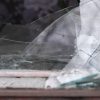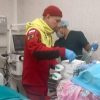«Eight of the nine 'returned' mosaic panels were fakes»
Leading scholars in France and Britain have accused New York authorities of repatriating fake Roman artifacts to Lebanon. Eight of the nine mosaic panels that US authorities recently returned to the Middle Eastern country are not real, according to Jamila Fellaguet of the University of Grenoble.
 Photo: thisisbeirut.com.lb
Photo: thisisbeirut.com.lb
The expert claims to have identified copies of mosaics at excavations and in museums in Italy, Tunisia, Algeria and Turkey. She claims to have found evidence that forgers copied designs from original mosaics in archaeological sites or museums in Sicily, Tunisia, Algeria and Turkey. “Eight out of nine “returned” mosaic panels were fakes, which were relatively easy to detect, since they used models of famous mosaics”, – says Jamila Fellage.
According to The Observer, she highlighted a panel depicting an angular giant, which, in her opinion, is based on a fragment of the famous mosaic at the Villa Romana del Casale in Sicily, listed as a UNESCO World Heritage Site.
Fellage also claims to have discovered that the mosaic of Neptune and Amphitrite was based on a mosaic found in Constantine, Algeria, which has been in the Louvre Museum in Paris since the mid-19th century. She claims that of the other mosaics returned to Lebanon, there is only one example that was inspired by a real mosaic from Lebanon – the well-known image of Bacchus in the National Museum in Beirut.
Christos Tsirogiannis, a visiting lecturer at the University of Cambridge and a leading expert on looted antiquities and trafficking networks, says the evidence is overwhelming. He said the revelation, if true, would be extremely embarrassing for the Manhattan district attorney's office, which announced the repatriation of the antiquities to Lebanon on Sept. 7.
His press release at the time said that nine mosaics included in the repatriation ceremony were among dozens of Middle Eastern and North African antiquities that were allegedly brought to New York by a Lebanese antiquities dealer.
In 2022, the District Attorney's Antiquities Trafficking Unit obtained a warrant for their arrest and applied for a Red Notice from Interpol.
“Even if you are not an expert, if you put a fake next to a genuine mosaic, you will see how similar they are, but also that the quality is actually not that good, “ states Tsirogiannis.
He added that the alleged forgers made the mistake of copying well-known mosaics that had been widely photographed by tourists with images widely available online and in scientific publications. “This is all madness. Authorities do things like this all the time without consulting experts.
Tsirogiannis directs research on antiquities trafficking for the UNESCO Chair on Threats to Cultural Heritage at the Ionian University in Corfu, Greece. Over 17 years, he identified more than 1,700 looted items, alerting police and governments and assisting in the repatriation of items.
As soon as Fellage saw photos of the mosaics in the press and online after the September announcement, she realized that most of them were «obvious fakes.»
“I struggled with the idea at first, telling myself that the investigation , which led to an arrest warrant, an Interpol Red Notice and restitution to the country, should have been the subject of a thorough scientific study”, – she said.
The woman began to investigate further: “Very quickly, during the search, I found models that counterfeiters used to make fakes.”
The expert says: “In the press and official press releases – on both the American and Lebanese sides — there has never been any scientific evidence proving that the mosaics were Roman, looted in Lebanon.
Before being seized by US authorities in 2021, one of the mosaics The panel was put up for sale in 2018 in a New York gallery with an estimate of less than $20,000.
Fellage suspects that the mosaic forger's workshop was located somewhere in the Middle East, probably in the 1970s and 1980s, judging by other works that appeared on the art market.
A spokesman for the district attorney denied these accusations. “In order for these antiquities to be repatriated, the court had to evaluate our evidence, which included expert analysis of their authenticity and important details about how they were illegally removed. The court concluded, based on evidence that these individuals do not have, that the fragments are genuine”.






















































Свежие комментарии